|
|
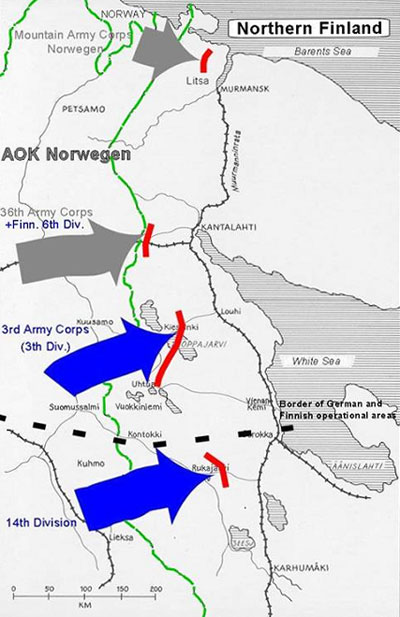 |
The Lion and The Eagle Part Two
Operation Silberfuchs
Return to Part One...
In the north Silberfuchs consisted of three separate thrusts, each one of which was along an east-west aimed at different points on the Murmansk railway. If any one of the thrusts was successful, the railway line to Moscow would be cut and supplies of Allied Lend-Lease equipment to the Soviet Union lost. However the vast northern wastes of Lapland meant that each attacking column was separated by over 200 miles, meaning:
• In the far north the Norwegian (German) Mountain Corps under General Deitl would cross the border, capture the Petsamo nickel mines, and press on over the Litsa River to Murmansk itself.
• In the centre the German 36th Corps, with the Finnish 6th Division attached, would advance along the rail line to recapture the town of Salla, and then across the Soviet frontier to capture Kantalahti on the shore of the White Sea.
|
• The southern-most prong of Silberfuchs was the Finnish 3rd Corps under General Silasvuo, which would attack from Suomussalmi along the road through Kiestinki to cut the railway at the town of Louhi.
• Although not part of Silberfuchs, just south of Finnish 3rd Corps the Finnish 14th Division, would attack from the Kuhmo sector in central Finland, along the road through Rukajarvi towards the railway north of Karhumaki. This would provide flank protection to 3rd Finnish Corps.
|
In the North - Platinfuchs
The northern arm of Silberfuchs was called Operation Platinfuchs (Platinum Fox). The attacking force comprised the German Mountain Corps (2nd and 3rd Gebirgsjager Divisions), veterans of the conquest of Norway, under the successful commander from that campaign, General Deitl. The Finnish Jalkava Rykmentti (Regiment) JR14 (2 battalions) and the Ivalo Border Guard Battalion joined them under German overall command (although still led by Finnish officers). The Corps moved from Kirkenes in Norway into Finland near Petsamo (Operation Reindeer).
|
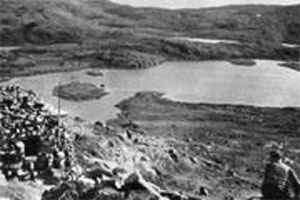 |
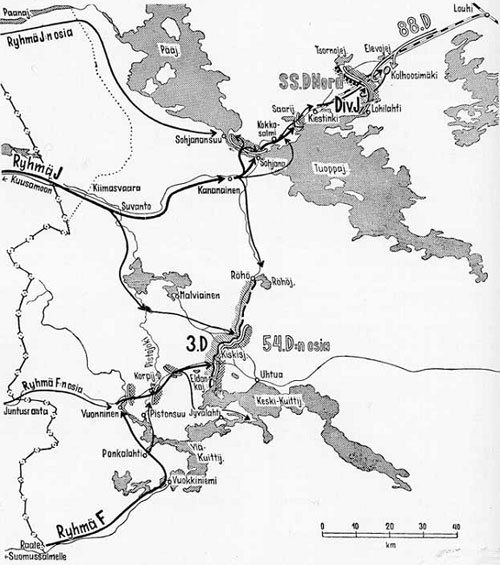 |
This enabled them to achieve almost complete surprise for the attack on the Soviets.
The attack started on 29th June 1941 across the barren, treeless waste of northern Lapland. The treeless terrain provided no cover. Worse, it was strewn with rocks making it almost impassable to vehicles. German troops actually had to build a new road as they advanced to enable supply vehicles to keep up. Deitl’s veteran troops made progress against the two defending Soviet Divisions, 14th Rifle and 52nd Rifle. If they could press on to Murmansk, the main landing port for Allied lend-lease supplies to the Soviets would be lost.
The Soviets resisted stubbornly however, and soon learned to zero their artillery on German vehicles advancing up the only road.
|
The Germans were forced to bring in pack mules instead, but these died in the cold. It became harder and harder to maintain the 500km supply line from Norway to sustain the advance. Finnish troops proved better able than the Germans to advance in the rugged terrain and cold, but were too few to affect the outcome.The Soviets dug in on the Litsa River, reinforced by naval infantry. On 22 September Deitl abandoned the offensive, and settled down to defensive positions, while transferring assault troops south.
|
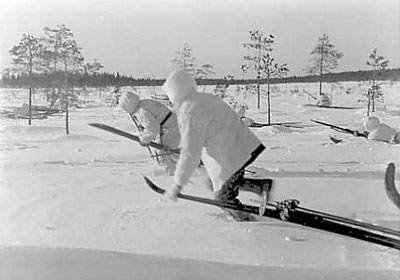
|
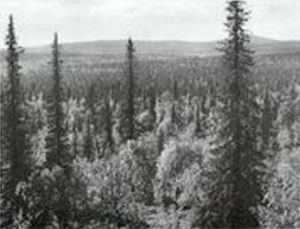
|
In the Centre - Polarfuchs
The central attack of Silberfuchs contained the German 36th Corps, their largest attacking force, consisting of the German 163rd and 169th Divisions, SS Nord Division, Panzer Abteilungs 40 and 211, and the Finnish 6th Division. The force was to attack from the Kuusamo region along the road from Salla to cut the Murmansk railway at the town of Kantalahti on the White Sea coast. Kuusamo is some 300 km south of Petsamo and surrounded by vast forests. It is still within the Artic Circle, and subject to intense cold.
|
The attack began against the defending Soviet 122nd and 104th Rifle Divisions, who were supported by the 1st Tank Brigade. The German 163rd and 169th Divisions attacked along the road and recaptured Salla. The single road through Salla was barely capable of supplying the attacking troops, and gave little opportunity to employ the Panzer units. They simply clogged the road and slowed the advance. The Finnish 6th Division attacked through the forest further south and bypassed Soviet defences. However in between the green SS Nord Division ran into trouble.
SS Nord was composed of volunteers strong on enthusiasm, but weak on training and being organised as a motorised division quite unsuited to the trackless forests. After two days they had lost over 700 casualties and broke upon a Soviet counterattack.
|
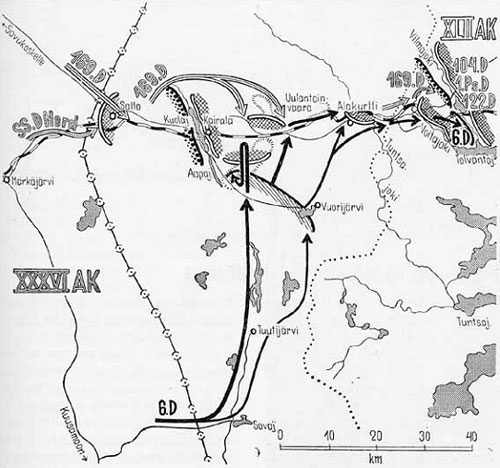 |
Nevertheless the rest of the force made some progress. With the help of the Finish 6th Division launching outflanking attaks from the south, the Soviets were pushed back some 40km to Alakurtti. However the congested road meant that the Germans always advanced slower than the Soviets could fall back. They dug in on the Vilmajoki (Vilma River), which prevented outflanking maneuvers, and could not be budged. The attack ended in mid-July.
|
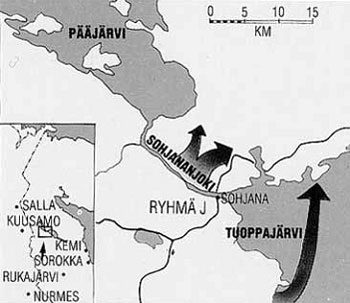 |
Attack Towards Kiestinki
Finnish III Corps was rather more grandly titled than it meritted. It had only Finnish 3rd Division, a brigade-sized force called “Division J” and the 8th and 9th Border Guard Battalions. However it was commanded by one of Finland’s best generals, Hjalmar Silasvuo, whohad led Finnish forces at the epic victory at Suomussalmi in the Winter War. It was to attack from Uhtua towards Keistinki and then the Murmansk railroad at Louhi. The terrain was dense forest similar to that at Kuusamo, although the more lightly equipped Finnish forces were much better able to advance through it without roads.
|
| The Finnish troops split into three forces to attack through the
forest, surrounding the defending Soviet 54th Rifle Division and taking
Uhtua. They then pressed on towards Keistinki, which lies between two
lakes, Paajarvi and Tuoppajarvi. At this point they were reinforced by
SS Nord and Panzer Abteilungs 40 and 211, since Polarfuchs was already
stymied. SS Nord was delierately parcelled out amoung Finnish units, in
the hope that it might learn forest fighting from the experts. |
|
The terrain in the region of Kiestinki, even by Finnish standards, was the worst imaginable for the use of motorised forces. Thick forest was everywhere, with the Soviet 88th Rifle Division lining the Sohjananjoki (Sohjana River) which linked the two lakes.
Being only July, the lakes were not frozen, making flank attacks difficult. Despite this, 3rd Division pressed the attack, supported by the Panzers. Remarkably the defences were cracked, and defenders fell back towards the town of Keistinki. Group J crossed the Sohjana River on 31 July 1941. Yet now the vehicles became a hindrance again, advancing slowly along the single road. Soviet defences again reformed east of Keistinki. Unknown to the Germans, the Finnish high command
ordered the attempt to cut the railroad to be halted, and the front
stabilised at this point, not to advancefurther in the next three
years. 3rd Division had fallen 40km short of its objective.
Continue to The Lion and The Eagle Part Three (Live on 11 March 2010)...
|
 |
Last Updated On Friday, January 29, 2010 by Blake at Battlefront
|
|